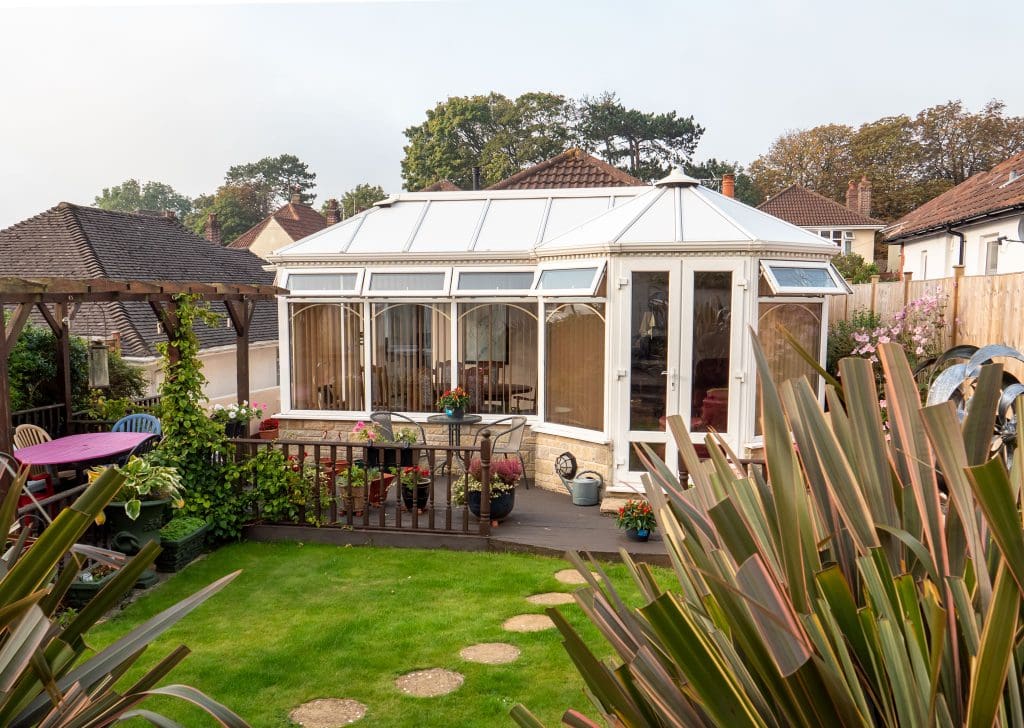Conservatories have long been in demand by homeowners in the United Kingdom. These light-filled space-expanders seamlessly bridge the gap between the outdoors and indoors, creating a unique living area. Whether you’re considering adding a conservatory to your home or you’re simply curious about what options are available, this guide will help you understand the world of conservatories and the options available in the UK.
We’ll look at the four main types of conservatories, offering a comprehensive look at their construction, intended use, and the roofing options that accompany them.
What are the Different Types of Conservatory?
Conservatories have become a well-loved feature of many homes in the United Kingdom, offering a gateway to the outdoors and providing a versatile living space. Conservatories come in a range of designs and, over time, have significantly evolved.
These historical structures date back to the 17th century and were originally designed as orangeries. The spaces were used mainly to protect plants from the cold British weather. Their warm interiors were perfect for growing citrus trees. As the years passed, these structures became extensions of living spaces that could be enjoyed all year round.
Selecting the right type of conservatory depends on your preferences, your home’s architecture, and the intended use of the space.
Conservatories are also a big investment and one that should be considered carefully. They can transform and add value to your property if selected well.
There are a range of conservatory types that vary in design, structure and décor. Here are the most popular:
- Gable-End Conservatory
- Victorian Conservatory
- Lean-To Conservatory
- Edwardian Conservatory
- Combination Conservatory
What is a Gable-End Conservatory?
The gable-end conservatory is a masterpiece of architectural design. Its distinctive front elevation showcases a sense of grandeur that can elevate any home’s aesthetics.
The construction of a gable-end conservatory typically features a high, sloping roof that creates a stunning apex, and the front of the roof doesn’t slope back to the middle. This offers an upright front of the conservatory that simulates the end of the house. It has a sense of space and elegance.
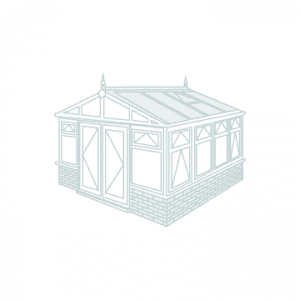
This type of conservatory often finds its place in period homes or properties with ample room. The design allows for considerable natural light, making it an ideal choice for those who want to flood their living spaces with sunlight.
The gable-end conservatory can serve a variety of purposes, from creating a sunny sitting room, housing beautiful plants or even as a home office, adding a new dimension to your living space.
What is a Victorian Conservatory?
Victorian conservatories are known for their classic charm and timeless elegance. They are the image that many picture when thinking of a typical conservatory. In keeping with Victorian architecture, the Victorian conservatory has many ornate and decorative features.
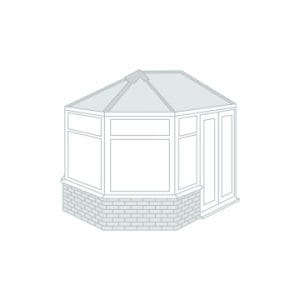
The construction of a Victorian conservatory typically features a bay front, a steeply pitched roof, embellished ridge details, and an elegant use of space.
Victorian conservatories offer great versatility in how space is used. They can be transformed into anything from an extended dining room to a play area for children. Because of their timeless design, they blend beautifully with both modern homes and period properties, making them an ever-popular choice among homeowners.
What is a Lean-To Conservatory?
If you’re looking for a more cost-effective option, the lean-to is a great way to add additional space to your home and still maintain a stylish appearance.
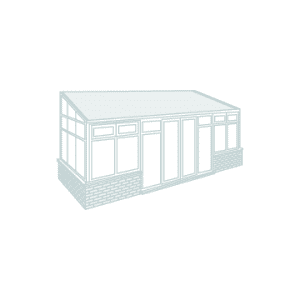
The lean-to-conservatory, also known as a sunroom or garden room, is a more contemporary addition to the conservatory family. Its straightforward design typically includes a single-pitched roof that leans against the host wall of your property. The longest walls will extend out into your garden or outside space. Most lean-to conservatories don’t require planning permission to be built.
This type of conservatory is ideal for those seeking a modern, minimalistic appearance and provides a perfect solution for properties struggling with limited space. It is easy to customise a lean-to conservatory, allowing it to serve a range of functions. They make ideal cosy lounging spaces, an additional area for dining or a relaxed zone to connect the outdoors with the indoors.
What is an Edwardian Conservatory?
The Edwardian Conservatory combines elements of classic and modern design.
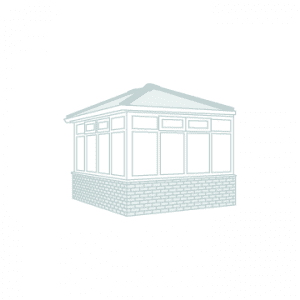
Their square or rectangular shape maximises the internal floor space, allowing for multifaceted use. The construction often features a high, sloping, rigid roof, clean lines, and an airy, spacious appearance.
Edwardian conservatories are suitable for properties of all types, and their blended design can be tailored to accommodate various functions and specifications. They can be a very popular option because they can often be uniquely designed to match the space you require. Whether it’s an additional living area or a bright and inviting kitchen extension, the Edwardian Conservatory brings a sense of sophistication and flexibility to your home.
Types of Conservatory Roof
After becoming more familiar with the types of conservatories available, it is next important to turn your focus to the roofing options.
The choice of roofing material can significantly impact your conservatory’s aesthetics, insulation, and overall comfort. Let’s look at the most two popular options:
Glass
Glass roofing is a traditional and widely used choice for conservatories. It comes in various categories, including self-cleaning conservatory glass, standard conservatory glass, and solar control conservatory glass. Each option offers unique benefits:
Self-Cleaning Conservatory Glass
Pleasingly, self-cleaning conservatory glass is designed to reduce the need for regular maintenance. It features a special coating that breaks down and loosens dirt when exposed to sunlight and rain. This low-maintenance glass aims to keep your conservatory clean and inviting without requiring excessive work. As with all types of glass, it can be susceptible to condensation if not properly ventilated or insulated.
Standard Conservatory Glass
Standard conservatory glass is another option, offering insulation and visibility. It allows natural light to flood your conservatory, creating a bright and inviting space for you to enjoy throughout the year. However, with this type of glass, it does require regular cleaning during the winter months to keep its appeal. It can also be affected by external temperature and needs attention to regulate it.
Solar Control Conservatory Glass
Solar control conservatory glass is specifically designed to manage temperature and glare within your conservatory. It offers thermal efficiency, preventing overheating in the summer months and maintaining a comfortable interior temperature. Although it is effective for its purpose, the main issue is the cost of solar control glass.
When comparing the cost of a standard unit and a solar glass unit, the cost of solar is almost three times more. Considering the amount of glass in a conservatory, this price difference will quickly amount to a large sum. It can, therefore, become a less attractive option.
Polycarbonate
The budgeter’s choice. Polycarbonate roofing is a lightweight and cost-effective alternative to glass. While it may not offer the same clarity and insulation as glass, it remains a popular choice for many conservatory owners because of its price point. It is important, however, to consider the long-term costs that may be incurred as a result of having a polycarbonate roof.
The panels have a relatively short life span compared to the other options, lasting only between 10-20 years. The price of replacing the panels more frequently should be factored into the long-term cost. These types of panels also have poor heat and sound insulation. Providing little insulation will mean that the house heating may need to be used to warm the space – this will add further costs in the future.
CosyPanels®
For those seeking an innovative, long-term roofing solution for their conservatory, CosyPanels is an excellent option to consider.
These insulated panels are designed to replace your existing conservatory roof, offering exceptional thermal efficiency and soundproofing. CosyPanels not only create a comfortable environment throughout the seasons but also reduce your energy bills and environmental footprint.
CosyPanels are precision-made from lightweight materials. Within every panel is a thick layer of insulation, which is densely packed. This helps to prevent the warm weather from making your conservatory too hot during the summer.
The panels are manufactured to fit your existing framework. They are made from a lightweight composition, and they contain up to 50mm of high-density foam insulation. This makes them significantly more efficient than polycarbonate panels. So, when you heat your house, the heat stays in.
Another benefit of CosyPanels is that they provide excellent soundproofing. This means that you can enjoy a relaxing evening in your conservatory during any weather without distraction.
Choosing the Best Conservatory for Your Home
Before making a final decision, it’s important to think carefully about what design and roofing suits your unique needs and preferences. Here is a quick roundup of the pros and cons of each of the conservatory styles discussed previously.
- Gable-End Conservatory: Ideal for those seeking style and space. They are best suited for period homes or properties with ample space. Doesn’t offer some of the more detailed elements that the others do.
- Victorian Conservatory: Perfect for classic charm and timeless elegance, suitable for both period properties and modern homes. The shape of the bay can sometimes hinder the placement of furniture.
- Lean-To Conservatory: A contemporary choice for minimalistic design, perfect for properties with limited space. Affordable option. Needs to be carefully planned to fit in with the current property. Adding accessories to the room can also be challenging.
- Edwardian Conservatory: A blend of classic and modern design, suitable for properties of all types, and offers versatility. It can lack a little character compared to the more ornate designs.
Once you have settled on your type of conservatory, it is then time to make your choice of roofing materials. These can significantly affect your conservatory’s comfort and efficiency. Remember to take into account the long-term investment and how you will be using the space.
For a long-term and reliable roofing solution, explore the innovative CosyPanels. These conservatory panels offer a high level of insulation, ensuring your conservatory remains a welcoming space throughout the year.
Are you ready to enhance your conservatory’s potential with the perfect roofing solution? It’s time to transform your living space into something extraordinary.
Book a free quote with CosyPanels® today and embark on a journey to create a more comfortable and energy-efficient conservatory.
Alternatively, for further insights and information, call us on 0800 75 66 882 or email us: info@cosypanels.co.uk

